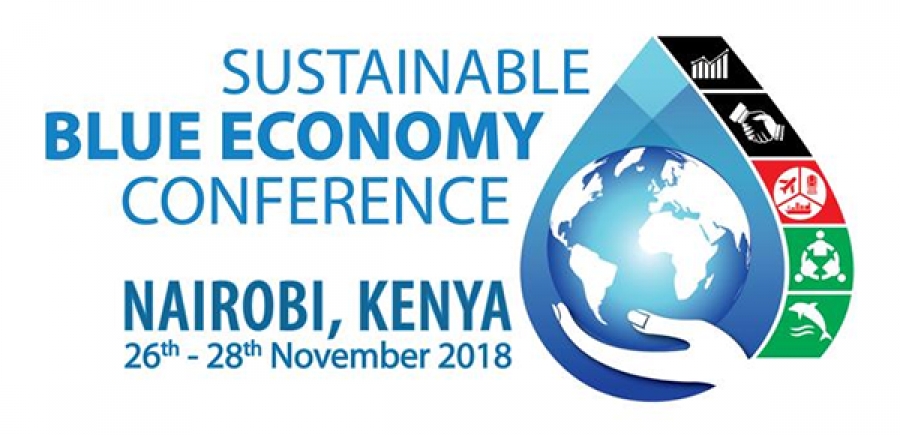Writren by: Rixcie Newball E-mail: Esta dirección de correo electrónico está siendo protegida contra los robots de spam. Necesita tener JavaScript habilitado para poder verlo.
The basics of the concept term “blue economy” was used then during the conference held in Miami in the early 2000´s, organized by the “White Water to Blue Water” Partnership (WW2BW) initiative, an international alliance of governments, international organizations, financial institutions, non-governmental organizations (NGOs), universities, and corporations, where stakeholders from around the world, mainly from the America´s, the Caribbean, and Europe, met to recreate the relations between waters located on land and waters from the seas and oceans. It was stated then that “…The initiative promotes regional cooperation and strengthens developing country capacity to address land-based sources of marine pollution (e.g. sewage and industrial discharges, agricultural run-off, etc.); promote sustainable fisheries, agricultural and forestry practices; meet challenges associated with tourism; and prevent the degradation of coastal areas...” (NOAA, 2018). Such initiative was launched to start first in the wider Caribbean region. Also, it was stated that the outcomes in the Caribbean will serve as a blueprint for future efforts in Africa and the South Pacific.
Years later, the term has evolved and now it is being managed as the relations between the use and conservation of water on land (rivers, lakes) and water in the oceans and seas (Conference, 2018). However, basically the concept is the same: the relations between the sustainable use of oceans, seas and marine resources, and its relations with coastal areas.
Stemming from such concept, the “Sustainable Blue Economy Conference” that was held in Nairobi, Kenya, during the 26-28 of November 2018, inspired by the unique global opportunity to build greater prosperity for all while protecting these water resources for the present and future generations, brought over 18,000 participants from across the world including Heads of State and Government, Ministers and high level representatives, mayors and governors, representatives of international organizations, the business community, the private sector, women and youth, Indigenous peoples, community based organizations, philanthropic, academic, scientific and research institutions, as well as civil society (Sustainable Blue Economy Conference, 2018), and had strategic conversations during this another global conference to agree on innovative use to improve the quality of life of those communities that depends on these water resources. The conference was an important platform for strategic deliberations on promoting the productivity, inclusivity and the sustainability aspects of the resources of a sustainable blue economy in an integrated, balanced and holistic manner.
Nine priority areas were identified, established, and deliberated during the conference:
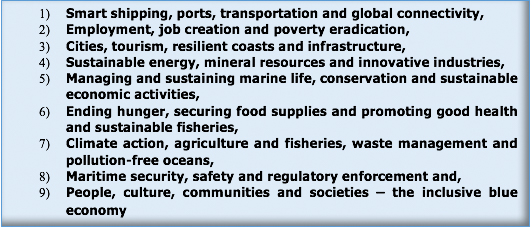
Because of its intention in contributing to the sustainable use of its water resources, seas, oceans, and coasts, Colombia too send a delegation of participants to be in these conversations. Such delegation was hosted by the Colombian Embassy in Kenya, led at the highest levels by the Ambassador self, Madam Mrs. Elizabeth Taylor, and her diplomatic staff. Delegates from Colombia included participants from the academics, government, NGO´s, and media sectors. From Seaflower were three persons, and 4 from mainland Colombia. Also present to the conference was Colombian citizens that lives in Nairobi and was participating in the different activities related to the conference.
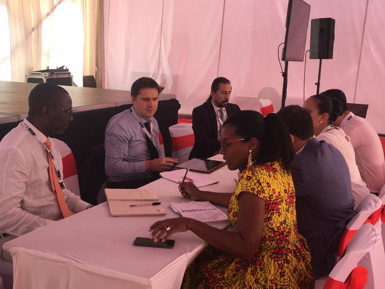 It´s important to note that a sustainable blue economy builds on unlocking the full economic possibilities of the oceans, seas, lakes, rivers and other water resources through investments that involve effective participation of all relevant people while protecting the resources for present and future generation and ecosystem resilience (Sustainable Blue Economy Conference, 2018). Countries and other stakeholders can, and should work closely to promote a sustainable blue economy by building understanding and galvanizing further action at various international forums. It is expected that at the 2020 United Nations Ocean Conference and at the United Nations General Assembly such close relationship would continue to encourage the implementations of the “Blue Economy” concepts.
It´s important to note that a sustainable blue economy builds on unlocking the full economic possibilities of the oceans, seas, lakes, rivers and other water resources through investments that involve effective participation of all relevant people while protecting the resources for present and future generation and ecosystem resilience (Sustainable Blue Economy Conference, 2018). Countries and other stakeholders can, and should work closely to promote a sustainable blue economy by building understanding and galvanizing further action at various international forums. It is expected that at the 2020 United Nations Ocean Conference and at the United Nations General Assembly such close relationship would continue to encourage the implementations of the “Blue Economy” concepts.
As for conversations established by the Colombian delegation, efforts were made to set up more dynamic activities with the UNEP and UN-Habitat program. Meetings was carried out with the European Union delegation representatives to such program (Union, 2018).
Especially it was addressed to continue foster future works around the adaptation and implementation of the “Circular Economy Strategy” concepts and methods in Colombia. The Colombian Ministry of Environment and Sustainable Development (MADS) has already working on ways to advance such strategy (MADS, 2018). There is a more advanced paper from the MADS, and it is expected to include regions like the Seaflower Biosphere Reserve, the Amazonian, and the Choco regions. Actions between these regions are expected to be leverage to enhances the advancing of the strategy by pilots that can later be maximized to the rest of the country.
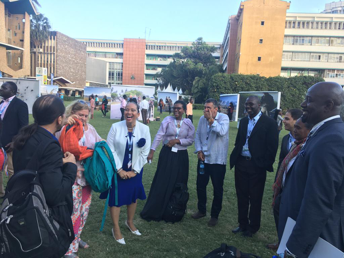 Other conversations were made during the conference, including activities at the University of Nairobi, where presentations were carried out by the delegation, promoting protected areas on the university campus. Similarly, participations in side events were made during the conference, for example women participation in the blue economy, islands and blue economy (along with Jamaica, Guyana, Virgin Islands, Trinidad and Tobago, and others).
Other conversations were made during the conference, including activities at the University of Nairobi, where presentations were carried out by the delegation, promoting protected areas on the university campus. Similarly, participations in side events were made during the conference, for example women participation in the blue economy, islands and blue economy (along with Jamaica, Guyana, Virgin Islands, Trinidad and Tobago, and others).
Achieving tangible results in the nine areas mentioned above will require new, bold and ambitious strategies, mobilization of significant financial resources, access to technologies and innovations, capacity building and effective governance arrangements. To mobilize requisite financial resources, the possibility of establishing a Blue Economy Investment Clearing House and Monitoring Facility (BEICHAMF) could be explored (Sustainable Blue Economy Conference, 2018). More than 60+ commitments were made during the conference. With the global community working individually and collectively, the pledges and commitments made during this conference can be implemented.
The following eight elements of principles of building of a sustainable blue economy were established:
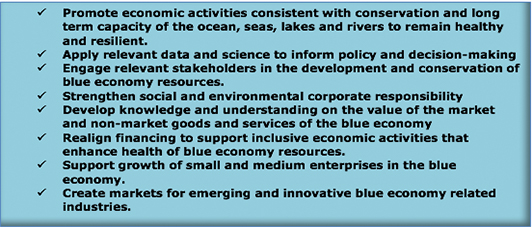
References
- Conference, S. B. (2018). Sustainable Blue Economy Conference.
- MADS, M. d. (2018). Estrategia Nacional de Economía Circular. Bogotá D.C.
- (2018, December 10). US Department of State. Retrieved from https://2001-2009.state.gov/g/oes/rls/fs/2003/18969.htm
- Sustainable Blue Economy Conference, N.-K. (2018). The Nairobi Statement of Intent on Advancing the Global Sustainable Blue Economy. Sustainable Blue Economy Conference, (p. 17). Nairobi.
- Union, E. (2018). Proposal for a Resolution on Sustainable Consumption and Production in a Cirlular Economy.
